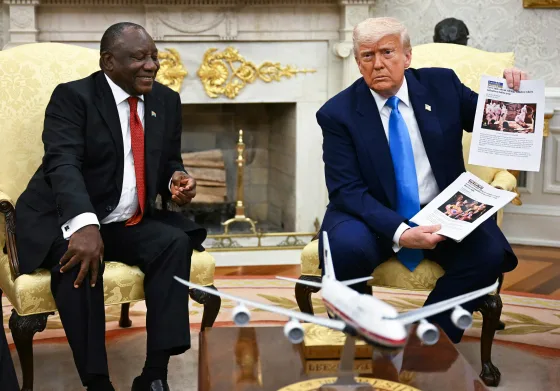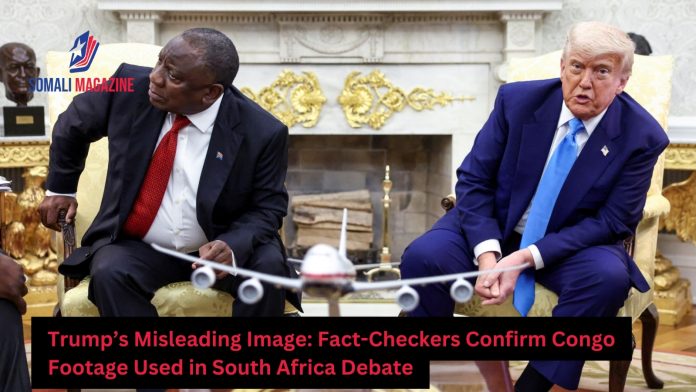Facebook Twitter (X) Instagram Somali Magazine - People's Magazine
U.S. President Donald Trump has come under scrutiny after presenting an image during a meeting with South African President Cyril Ramaphosa that he claimed showed white farmers killed in South Africa. However, fact-checkers have confirmed that the image was actually a screenshot from Reuters footage taken in the Democratic Republic of Congo, depicting humanitarian workers handling body bags following clashes with M23 rebels.
The incident occurred during a tense Oval Office meeting, where Trump attempted to highlight what he described as the persecution of white South Africans. Holding up a printout of an article featuring the image, he insisted that it was evidence of mass killings. However, the footage, originally published by Reuters in February, was later verified to be from Goma, Congo, and had no connection to South Africa.
The image was sourced from a blog post published by American Thinker, a conservative online magazine that discussed racial tensions in South Africa and Congo. The post did not caption the image but identified it as a “YouTube screen grab” linked to a video news report about Congo. The White House has not responded to requests for clarification regarding Trump’s use of the misleading image.
Reuters journalist Djaffar Al Katanty, who filmed the original footage, expressed shock upon seeing his work misrepresented. “President Trump used my image, used what I filmed in DRC to try to convince President Ramaphosa that in his country, white people are being killed by Black people,” Al Katanty stated.

Ramaphosa, who visited Washington to mend diplomatic ties, was visibly taken aback by Trump’s claims. The South African government has repeatedly denied allegations that white farmers are being systematically targeted, dismissing such narratives as conspiracy theories propagated by far-right groups.
Trump’s remarks have reignited debates over misinformation and the role of political rhetoric in shaping international relations. His claims about white genocide in South Africa have circulated in far-right circles for years, despite a lack of credible evidence. South African crime statistics do not support the notion that white farmers face disproportionate violence compared to other demographics.
The controversy has also drawn criticism from media watchdogs and human rights organizations, who warn that the spread of false narratives can fuel racial tensions and undermine diplomatic efforts. Analysts argue that Trump’s use of the image reflects a broader pattern of misinformation influencing political discourse.
As the fallout continues, the White House has yet to issue a formal statement addressing the misrepresentation. Meanwhile, South African officials remain focused on strengthening bilateral relations and countering false narratives that could impact international perceptions of the country.

